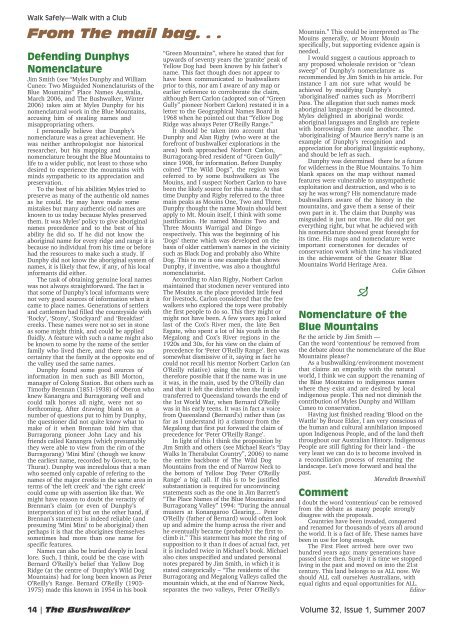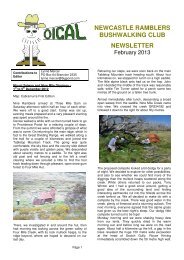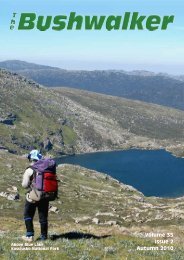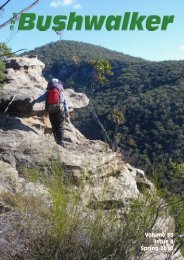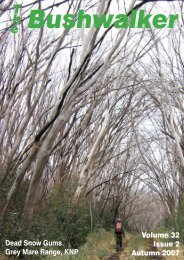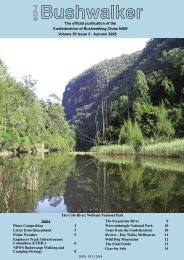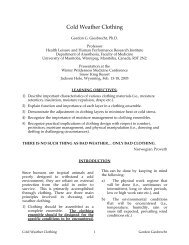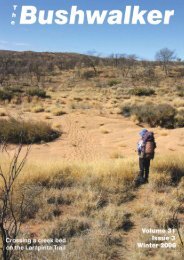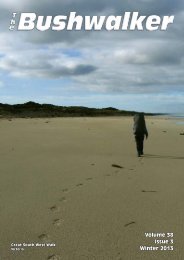Volume 32 Issue 1 Summer 2007 - Confederation of Bushwalking ...
Volume 32 Issue 1 Summer 2007 - Confederation of Bushwalking ...
Volume 32 Issue 1 Summer 2007 - Confederation of Bushwalking ...
- No tags were found...
You also want an ePaper? Increase the reach of your titles
YUMPU automatically turns print PDFs into web optimized ePapers that Google loves.
Walk Safely—Walk with a Club<br />
From The mail bag. . .<br />
Defending Dunphys<br />
Nomenclature<br />
Jim Smith (see “Myles Dunphy and William<br />
Cuneo: Two Misguided Nomenclaturists <strong>of</strong> the<br />
Blue Mountains” Place Names Australia,<br />
March 2006, and The Bushwalker, Winter<br />
2006) takes aim at Myles Dunphy for his<br />
nomenclatural work in the Blue Mountains,<br />
accusing him <strong>of</strong> stealing names and<br />
misappropriating others.<br />
I personally believe that Dunphy’s<br />
nomenclature was a great achievement. He<br />
was neither anthropologist nor historical<br />
researcher, but his mapping and<br />
nomenclature brought the Blue Mountains to<br />
life to a wider public, not least to those who<br />
desired to experience the mountains with<br />
minds sympathetic to its appreciation and<br />
preservation.<br />
To the best <strong>of</strong> his abilities Myles tried to<br />
preserve as many <strong>of</strong> the authentic old names<br />
as he could. He may have made some<br />
mistakes but many authentic old names are<br />
known to us today because Myles preserved<br />
them. It was Myles’ policy to give aboriginal<br />
names precedence and to the best <strong>of</strong> his<br />
ability he did so. If he did not know the<br />
aboriginal name for every ridge and range it is<br />
because no individual from his time or before<br />
had the resources to make such a study. If<br />
Dunphy did not know the aboriginal system <strong>of</strong><br />
names, it is likely that few, if any, <strong>of</strong> his local<br />
informants did either.<br />
The task <strong>of</strong> obtaining genuine local names<br />
was not always straightforward. The fact is<br />
that some <strong>of</strong> Dunphy’s local informants were<br />
not very good sources <strong>of</strong> information when it<br />
came to place names. Generations <strong>of</strong> settlers<br />
and cattlemen had filled the countryside with<br />
‘Rocky’, ‘Stony’, ‘Stockyard’ and ‘Breakfast’<br />
creeks. These names were not so set in stone<br />
as some might think, and could be applied<br />
fluidly. A feature with such a name might also<br />
be known to some by the name <strong>of</strong> the settler<br />
family who lived there, and there was no<br />
certainty that the family at the opposite end <strong>of</strong><br />
the valley used the same names.<br />
Dunphy found some good sources <strong>of</strong><br />
information in men such as Bill Morton,<br />
manager <strong>of</strong> Colong Station. But others such as<br />
Timothy Brennan (1851-1938) <strong>of</strong> Oberon who<br />
knew Kanangra and Burragorang well and<br />
could talk horses all night, were not so<br />
forthcoming. After drawing blank on a<br />
number <strong>of</strong> questions put to him by Dunphy,<br />
the questioner did not quite know what to<br />
make <strong>of</strong> it when Brennan told him that<br />
Burragorang pioneer John Lacy and his<br />
friends called Kanangra (which presumably<br />
they were able to view from the rim <strong>of</strong> the<br />
Burragorang) ‘Mini Mini’ (though we know<br />
the earliest name, recorded by Govett, to be<br />
Thurat). Dunphy was incredulous that a man<br />
who seemed only capable <strong>of</strong> refering to the<br />
names <strong>of</strong> the major creeks in the same area in<br />
terms <strong>of</strong> ‘the left creek’ and ‘the right creek’<br />
could come up with assertion like that. We<br />
might have reason to doubt the veracity <strong>of</strong><br />
Brennan’s claim (or even <strong>of</strong> Dunphy’s<br />
interpretation <strong>of</strong> it) but on the other hand, if<br />
Brennan’s statement is indeed reliable (and<br />
presuming ‘Mini Mini’ to be aboriginal) then<br />
perhaps it is that the aborigines themselves<br />
sometimes had more than one name for<br />
specific features.<br />
Names can also be buried deeply in local<br />
lore. Such, I think, could be the case with<br />
Bernard O’Reilly’s belief that Yellow Dog<br />
Ridge (at the centre <strong>of</strong> Dunphy’s Wild Dog<br />
Mountains) had for long been known as Peter<br />
O’Reilly’s Range. Bernard O’Reilly (1903-<br />
1975) made this known in 1954 in his book<br />
“Green Mountains”, where he stated that for<br />
upwards <strong>of</strong> seventy years the ‘granite’ peak <strong>of</strong><br />
Yellow Dog had been known by his father’s<br />
name. This fact though does not appear to<br />
have been communicated to bushwalkers<br />
prior to this, nor am I aware <strong>of</strong> any map or<br />
earlier reference to corroborate the claim,<br />
although Bert Carlon (adopted son <strong>of</strong> “Green<br />
Gully” pioneer Norbert Carlon) restated it in a<br />
letter to the Geographical Names Board in<br />
1968 when he pointed out that “Yellow Dog<br />
Ridge was always Peter O’Reilly Range.”<br />
It should be taken into account that<br />
Dunphy and Alan Rigby (who were at the<br />
forefront <strong>of</strong> bushwalker explorations in the<br />
area) both approached Norbert Carlon,<br />
Burragorang-bred resident <strong>of</strong> “Green Gully”<br />
since 1908, for information. Before Dunphy<br />
coined “The Wild Dogs”, the region was<br />
referred to by some bushwalkers as The<br />
Mouins, and I suspect Norbert Carlon to have<br />
been the likely source for this name. At that<br />
time Dunphy and Rigby referred to the three<br />
main peaks as Mouins One, Two and Three.<br />
Dunphy thought the name Mouin should best<br />
apply to Mt. Mouin itself, I think with some<br />
justification. He named Mouins Two and<br />
Three Mounts Warrigal and Dingo<br />
respectively. This was the beginning <strong>of</strong> his<br />
‘Dogs’ theme which was developed on the<br />
basis <strong>of</strong> older cattlemen’s names in the vicinity<br />
such as Black Dog and probably also White<br />
Dog. This to me is one example that shows<br />
Dunphy, if inventive, was also a thoughtful<br />
nomenclaturist.<br />
According to Alan Rigby, Norbert Carlon<br />
maintained that stockmen never ventured into<br />
The Mouins as the place provided little feed<br />
for livestock. Carlon considered that the few<br />
walkers who explored the tops were probably<br />
the first people to do so. This they might or<br />
might not have been. A few years ago I asked<br />
last <strong>of</strong> the Cox’s River men, the late Ben<br />
Esgate, who spent a lot <strong>of</strong> his youth in the<br />
Megalong and Cox’s River regions in the<br />
1920s and 30s, for his view on the claim <strong>of</strong><br />
precedence for ‘Peter O’Reilly Range’. Ben was<br />
somewhat dismissive <strong>of</strong> it, saying in fact he<br />
could not recall his mentor Norbert Carlon (an<br />
O’Reilly relative) using the term. It is<br />
therefore possible that if the name was in use<br />
it was, in the main, used by the O’Reilly clan<br />
and that it left the district when the family<br />
transferred to Queensland towards the end <strong>of</strong><br />
the 1st World War, when Bernard O’Reilly<br />
was in his early teens. It was in fact a voice<br />
from Queensland (Bernard’s) rather than (as<br />
far as I understand it) a clamour from the<br />
Megalong that first put forward the claim <strong>of</strong><br />
precedence for ‘Peter O’Reilly Range’.<br />
In light <strong>of</strong> this I think the proposition by<br />
Jim Smith and others (see Michael Keat’s “Day<br />
Walks In Therabulat Country”, 2006) to name<br />
the entire backbone <strong>of</strong> The Wild Dog<br />
Mountains from the end <strong>of</strong> Narrow Neck to<br />
the bottom <strong>of</strong> Yellow Dog ‘Peter O’Reilly<br />
Range’ a big call. If this is to be justified<br />
substantiation is required for unconvincing<br />
statements such as the one in Jim Barrett’s<br />
“The Place Names <strong>of</strong> the Blue Mountains and<br />
Burragorang Valley” 1994: “During the annual<br />
musters at Konangaroo Clearing… Peter<br />
O’Reilly (father <strong>of</strong> Bernard) would <strong>of</strong>ten look<br />
up and admire the hump across the river and<br />
he eventually became (probably) the first to<br />
climb it.” This statement has more the ring <strong>of</strong><br />
supposition to it than it does <strong>of</strong> actual fact, yet<br />
it is included twice in Michael’s book. Michael<br />
also cites unspecified and undated personal<br />
notes prepared by Jim Smith, in which it is<br />
stated categorically – “The residents <strong>of</strong> the<br />
Burragorang and Megalong Valleys called the<br />
mountain which, at the end <strong>of</strong> Narrow Neck,<br />
separates the two valleys, Peter O’Reilly’s<br />
Mountain.” This could be interpreted as The<br />
Mouins generally, or Mount Mouin<br />
specifically, but supporting evidence again is<br />
needed.<br />
I would suggest a cautious approach to<br />
any proposed wholesale revision or “clean<br />
sweep” <strong>of</strong> Dunphy’s nomenclature as<br />
recommended by Jim Smith in his article. For<br />
instance I am not sure what would be<br />
achieved by modifying Dunphy’s<br />
‘aboriginalised’ names such as Morriberri<br />
Pass. The allegation that such names mock<br />
aboriginal language should be discounted.<br />
Myles delighted in aboriginal words:<br />
aboriginal languages and English are replete<br />
with borrowings from one another. The<br />
‘aboriginalising’ <strong>of</strong> Maurice Berry’s name is an<br />
example <strong>of</strong> Dunphy’s recognition and<br />
appreciation for aboriginal linguistic euphony,<br />
and should be left as such.<br />
Dunphy was determined there be a future<br />
for wilderness in the Blue Mountains. To him<br />
blank spaces on the map without named<br />
features were vulnerable to unsympathetic<br />
exploitation and destruction, and who is to<br />
say he was wrong His nomenclature made<br />
bushwalkers aware <strong>of</strong> the history in the<br />
mountains, and gave them a sense <strong>of</strong> their<br />
own part in it. The claim that Dunphy was<br />
misguided is just not true. He did not get<br />
everything right, but what he achieved with<br />
his nomenclature showed great foresight for<br />
its time. His maps and nomenclature were<br />
important cornerstones for decades <strong>of</strong><br />
conservation work which time has vindicated<br />
in the achievement <strong>of</strong> the Greater Blue<br />
Mountains World Heritage Area.<br />
Colin Gibson<br />
Nomenclature <strong>of</strong> the<br />
Blue Mountains<br />
Re the article by Jim Smith —<br />
Can the word ‘contentious’ be removed from<br />
the debate about the nomenclature <strong>of</strong> the Blue<br />
Mountains please<br />
As a bushwalking/environment movement<br />
that claims an empathy with the natural<br />
world, I think we can support the renaming <strong>of</strong><br />
the Blue Mountains to indigenous names<br />
where they exist and are desired by local<br />
indigenous people. This ned not diminish the<br />
contribution <strong>of</strong> Myles Dunphy and William<br />
Cuneo to conservation.<br />
Having just finished reading ‘Blood on the<br />
Wattle’ by Bruce Elder, I am very conscious <strong>of</strong><br />
the human and cultural annihilation imposed<br />
upon Indigenous People, and <strong>of</strong> the land theft<br />
throughout our Australian History. Indigenous<br />
People are still fighting for their land - the<br />
very least we can do is to become involved in<br />
a reconciliation process <strong>of</strong> renaming the<br />
landscape. Let’s move forward and heal the<br />
past.<br />
Meredith Brownhill<br />
Comment<br />
I doubt the word ‘contentious’ can be removed<br />
from the debate as many people strongly<br />
disagree with the proposals.<br />
Countries have been invaded, conquered<br />
and renamed for thousands <strong>of</strong> years all around<br />
the world. It is a fact <strong>of</strong> life. These names have<br />
been in use for long enough.<br />
The First Fleet arrived here over two<br />
hundred years ago: many generations have<br />
passed since then. Surely it is time we stopped<br />
living in the past and moved on into the 21st<br />
century. This land belongs to us ALL now. We<br />
should ALL call ourselves Australians, with<br />
equal rights and equal opportunities for ALL.<br />
Editor<br />
14 | The Bushwalker <strong>Volume</strong> <strong>32</strong>, <strong>Issue</strong> 1, <strong>Summer</strong> <strong>2007</strong>


